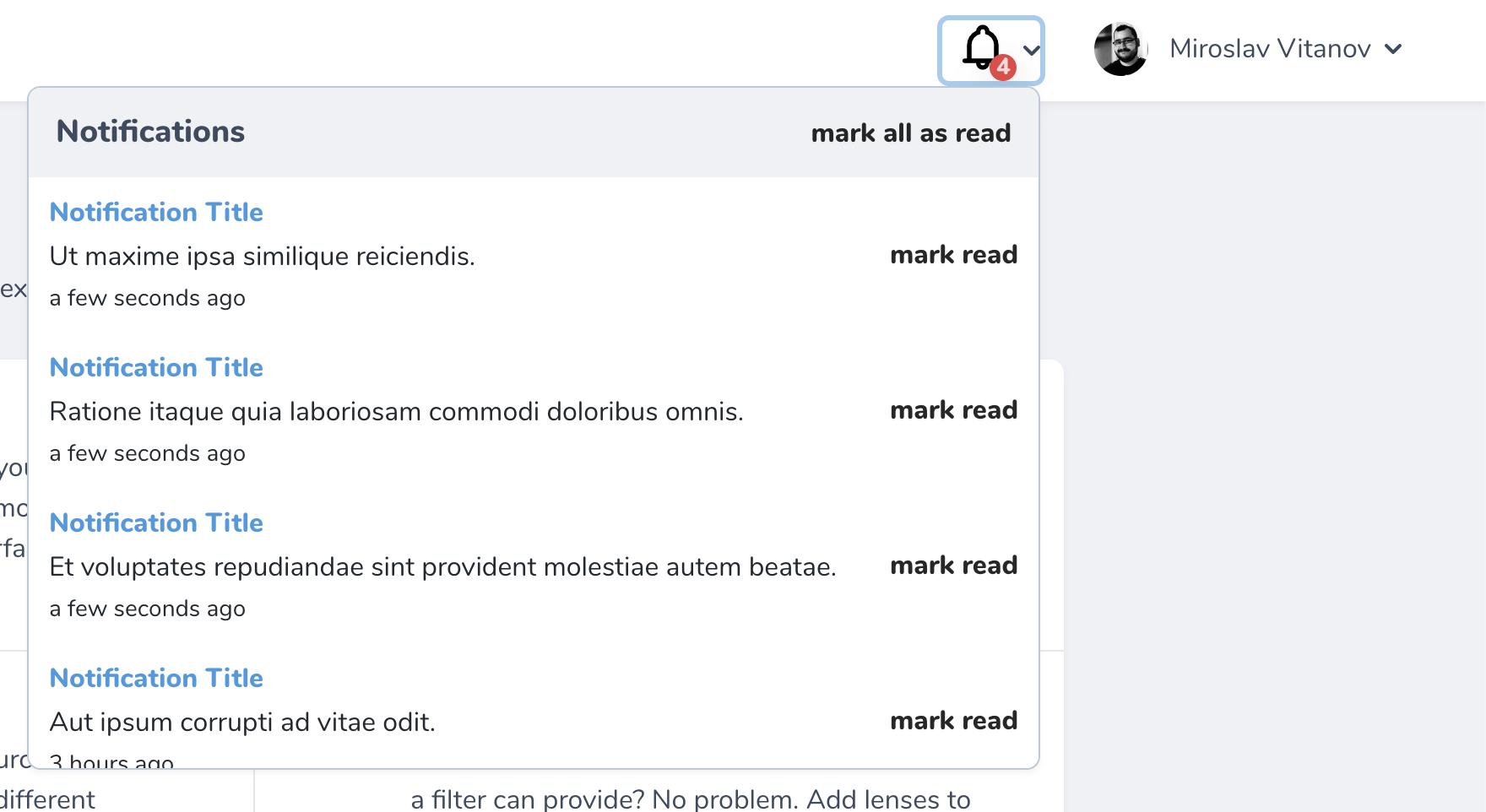| Package Data | |
|---|---|
| Maintainer Username: | mirovit |
| Package Create Date: | 2020-04-02 |
| Package Last Update: | 2023-03-07 |
| Language: | PHP |
| License: | MIT |
| Last Refreshed: | 2025-12-18 15:23:58 |
| Package Statistics | |
|---|---|
| Total Downloads: | 107,570 |
| Monthly Downloads: | 636 |
| Daily Downloads: | 16 |
| Total Stars: | 64 |
| Total Watchers: | 4 |
| Total Forks: | 25 |
| Total Open Issues: | 14 |
Install via composer composer require mirovit/nova-notifications.
Laravel will auto-register the Service Provider. You'll need to register the tool with Laravel Nova.
public function tools()
{
return [
// ...
\Mirovit\NovaNotifications\NovaNotifications::make(),
];
}
Make sure you have the user channel authenticated in routes/channels.php or where you store this logic:
Broadcast::channel('App.Models.User.{id}', function ($user, $id) {
return (int)$user->id === (int)$id;
});
Laravel Echo is not bundled with Nova by defult, so you will need to setup that for your front end. To do that follow these steps below:
npm install
import Echo from 'laravel-echo';
// Sample instance with Pusher
window.Pusher = require('pusher-js');
window.Echo = new Echo({
broadcaster: 'pusher',
key: process.env.MIX_PUSHER_APP_KEY,
cluster: process.env.MIX_PUSHER_APP_CLUSTER,
encrypted: true
});
mix.js('resources/js/admin.js', 'public/js');
// ...
<script src="{{ mix('app.js', 'vendor/nova') }}"></script>
<script src="{{ mix('js/admin.js') }}"></script>
Additionally, the package assumes that models are namespaced as App\Models, if that is not correct for your project, the authentication between the front & back end will not work and notifications will not show without refreshing the page. Go to the Configuration section to see how to fix this.
The last step is to publish manually Nova's layout file if you haven't done so.
cp vendor/laravel/nova/resources/views/layout.blade.php resources/views/vendor/nova/layout.blade.php
Then place the partial view that displays the bell icon in the nav bar, somewhere aroud the user partial from nova - @include('nova-notifications::dropdown').
Trigger a notification from Laravel. Sample notification:
<?php
namespace App\Notifications;
use App\User;
use Illuminate\Bus\Queueable;
use Illuminate\Contracts\Queue\ShouldQueue;
use Illuminate\Notifications\Messages\BroadcastMessage;
use Illuminate\Notifications\Messages\MailMessage;
use Illuminate\Notifications\Notification;
class Created extends Notification
{
use Queueable;
private $user;
/**
* Create a new notification instance.
*
* @param User $user
*/
public function __construct(User $user)
{
$this->user = $user;
}
/**
* Get the notification's delivery channels.
*
* @param mixed $notifiable
* @return array
*/
public function via($notifiable)
{
return ['database', 'broadcast'];
}
/**
* Get the array representation of the notification.
*
* @param mixed $notifiable
* @return array
*/
public function toArray($notifiable)
{
return \Mirovit\NovaNotifications\Notification::make()
->info('A new user was created.')
->subtitle('There is a new user in the system - ' . $this->user->name . '!')
->routeDetail('users', $this->user->id)
->toArray();
}
}
Notification::make($title = null, $subtitle = null)
// Sets title
->title(string $value)
// Sets subtitle
->subtitle(string $subtitle)
// Link and route work similarly. Route has precedence over link, if you define both on an instance. You should generally use a one of them.
->link(string $url, bool $external = false)
// Route to internal resource
->route(string $name, string $resourceName, $resourceId = null)
// Helper methods for resource routing
->routeIndex(string $resourceName)
->routeCreate(string $resourceName)
->routeEdit(string $resourceName, $resourceId)
->routeDetail(string $resourceName, $resourceId)
// Notification level - info, success or error
->level(string $value)
// Helpers to set title and level with one call
->info(string $value)
->success(string $value)
->error(string $value)
// Set custom date for notification, defaults to current datetime
->createdAt(Carbon $value)
// Add icon classes to be applied, ex: fas fa-info
->icon(string $value)
->showMarkAsRead(bool $value = true)
->showCancel(bool $value = true)
->toArray();
In order to show the icons, you need to make sure they are imported in your project. You can use any icon font like Font Awesome.
Example usage of FA:
In layout.blade.php add the CSS for FA.
Then just add the->icon() method on your notification and specify the classes for rendering the icon fas fa-info.
There is an optional config file published by the package. If you use a different convention for model namespaces or you want to override the default controllers provided by the package, then you'll need to publish the configuration into your project.
Note that the default model namespace that the package assumes is App\Models, so if you're using another namespace, this will have to be adjusted for the authentication between the API and the front end.
php artisan vendor:publish and select the number corresponding to Mirovit\NovaNotifications\NovaNotificationsServiceProvider or publish all.
The package has been translated into English, if you require additional translations, you can add them as documented in the Laravel Nova docs.
An item that has come up a few times is that the difference for humans is displayed only in English, regardless of the application locale. You need to set the moment.js locale in your application to the appropriate locale, this is not a responsibility of this package.
Locate your layout file - resources/views/vendor/nova/layout.blade.php:
Find:
<!-- Build Nova Instance -->
<script>
window.Nova = new CreateNova(config)
</script>
and replace with:
<!-- Build Nova Instance -->
<script>
window.Nova = new CreateNova(config)
moment.locale('es-es') // this can come from a config setting, just an example of how to set it
</script>






